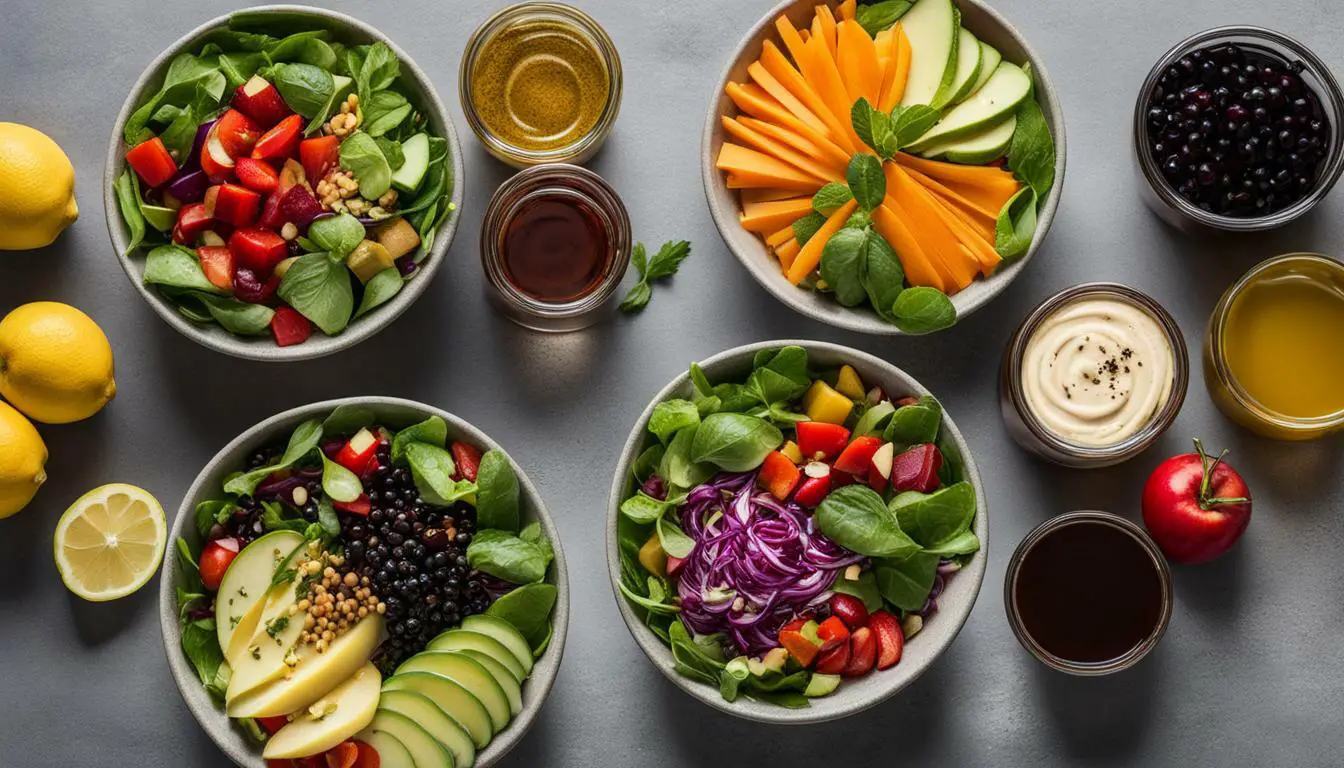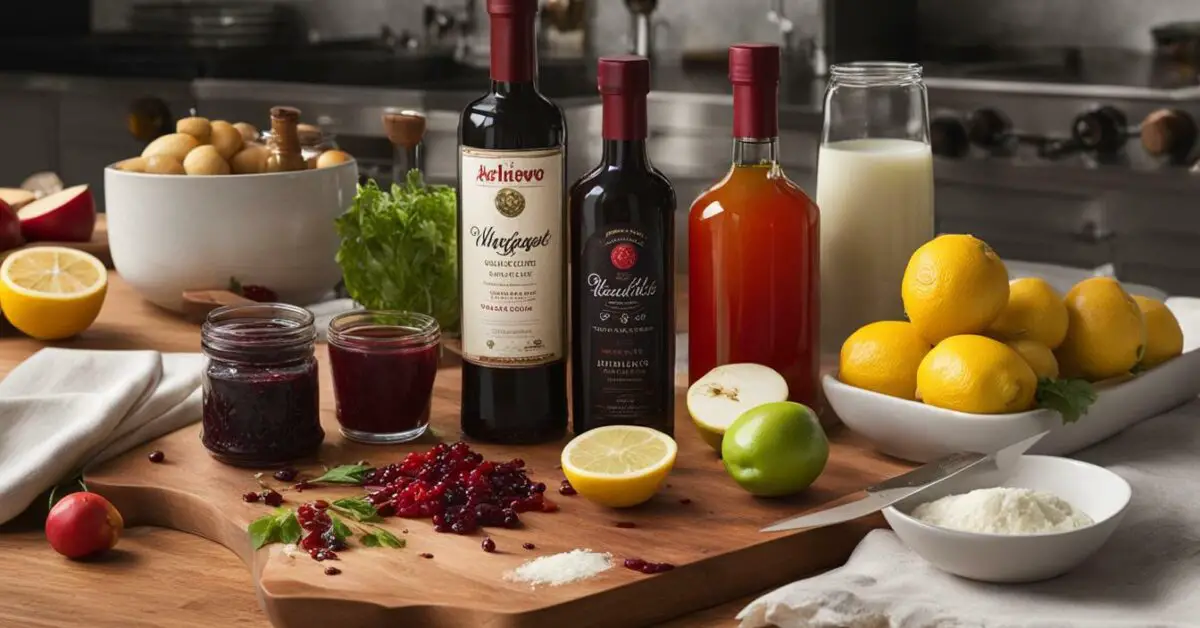
This post may contain affiliate links. Please read my disclosure for more information.
When making vinaigrette and looking for substitutes for vinegar, you have several options to consider. There are tangy alternatives that can help you reinvent your salads with exciting flavors.
One way to substitute vinegar is to adjust the proportions of oil to vinegar, using a smaller amount of vinegar. This allows you to maintain a tangy taste while reducing the overall acidity.
Another option is to use high-quality ingredients, such as balsamic vinegar or infused vinegars. These can add depth and complexity to your vinaigrette, elevating the overall taste of your salad.
If you prefer a more robust flavor, you can try using more flavorful oils, like walnut or avocado oil, and lighter vinegars, such as white wine vinegar or champagne vinegar. This combination can provide a unique and balanced taste to your vinaigrette.
Alternatively, you can substitute alternative acidic ingredients for vinegar. Wine, orange juice, lemon juice, or even Champagne can add a tangy and refreshing twist to your vinaigrette. It’s all about experimenting and finding the perfect combination that suits your palate.
Finally, if you want to skip the traditional salad dressing route, you can focus on enhancing the flavors of your salad through other ingredients. Fresh herbs, spices, or even a squeeze of citrus can bring new life to your greens without the need for vinegar-based dressings.
When it comes to specific vinegar substitutes for vinaigrette recipes, you have a variety of options. White wine vinegar, apple cider vinegar, rice vinegar, and wine vinegar can all be used depending on the recipe. If you’re looking for a substitute for red wine vinegar, you can try a combination of red cooking wine and white wine vinegar, or opt for white wine vinegar, sherry vinegar, apple cider vinegar, or lemon juice. The choice is yours.
Remember, experimenting with flavors is key to creating a vinaigrette that enhances the taste of your salad. Don’t be afraid to think outside the bottle of vinegar and explore the multitude of options available to you. Whether you choose to adjust proportions, use high-quality ingredients, explore different oil and vinegar combinations, or substitute alternative acidic ingredients, there’s a world of vinaigrette substitutes waiting to be discovered.
Specific Vinegar Substitutes for Vinaigrette Recipes
If you’re looking for specific vinegar substitutes in your vinaigrette recipes, there are different options you can try depending on the type of vinegar you need to replace. Here are some alternatives that can add a unique twist to your vinaigrettes:
- White Wine Vinegar: This mild and slightly sweet vinegar can be used as a substitute for most types of vinegar in vinaigrette recipes. It pairs well with a variety of flavors and can add a delicate tanginess to your dressings.
- Apple Cider Vinegar: Known for its slightly fruity and acidic flavor, apple cider vinegar can be used as a substitute for white wine vinegar or other light-colored vinegars. It adds a subtle sweetness to your vinaigrettes and pairs particularly well with salads that contain fruits or roasted vegetables.
- Rice Vinegar: Commonly used in Asian cuisine, rice vinegar has a milder and slightly sweeter taste compared to other vinegars. It works well as a substitute for white wine vinegar or other light-colored vinegars, adding a touch of brightness to your vinaigrettes.
- Wine Vinegar: Red or white wine vinegar can be used as a substitute for different types of vinegar depending on the recipe. Red wine vinegar can be replaced with a combination of red cooking wine and white wine vinegar, white wine vinegar, sherry vinegar, apple cider vinegar, or even lemon juice.
These vinegar substitutes offer a range of flavors that can enhance your vinaigrette recipes. Experiment with different combinations to find the perfect balance that suits your taste buds. Remember, vinaigrettes are versatile, and switching up the vinegar can completely transform the overall flavor profile of your salads. Enjoy the creative journey and discover new ways to make your salads more exciting!
Conclusion
Substituting vinegar in vinaigrette opens up a world of possibilities to experiment with flavors and enhance the taste of your salads. When making vinaigrette and looking for substitutes for vinegar, there are several options to consider.
One way is to adjust the proportions of oil to vinegar by using a smaller amount of vinegar. This allows the other ingredients in your vinaigrette to shine while still providing a hint of tanginess. Alternatively, you can use high-quality ingredients such as balsamic vinegar or infused vinegars to add depth and complexity to your dressing.
If you’re looking to explore different flavor profiles, try pairing more robust oils with lighter vinegars. This combination can create a unique balance of richness and acidity. And if you’re looking to go beyond vinegar altogether, consider substituting alternative acidic ingredients like wine, orange juice, lemon juice, or Champagne. These ingredients can bring a bright and refreshing twist to your vinaigrette.
Ultimately, the key to finding the perfect substitute for vinegar in vinaigrette is to experiment and find a combination of flavors that you enjoy. Whether you’re adjusting proportions, using high-quality ingredients, exploring different oil and vinegar combinations, or trying alternative acidic ingredients, don’t be afraid to get creative and enhance the flavors of your salads in new and exciting ways.
FAQ
How can I substitute vinegar in vinaigrette?
There are several options to consider when substituting vinegar in vinaigrette. You can adjust the proportions of oil to vinegar by using a smaller amount of vinegar. Alternatively, you can use high-quality ingredients like balsamic vinegar or infused vinegars. Another option is to experiment with more robust oils and lighter vinegar or substitute alternative acidic ingredients such as wine, orange juice, lemon juice, or Champagne. You can also skip the salad dressing altogether and focus on enhancing the flavors of the salad through other ingredients.
What specific vinegar substitutes can I use in vinaigrette recipes?
Depending on the recipe, you can substitute vinegar with white wine vinegar, apple cider vinegar, rice vinegar, or wine vinegar. For red wine vinegar, you can try a combination of red cooking wine and white wine vinegar, white wine vinegar, sherry vinegar, apple cider vinegar, or lemon juice.
What should I keep in mind when substituting vinegar in vinaigrette?
It’s important to experiment and find a combination of flavors that you enjoy. Taste test as you go to adjust the proportions or ingredients as needed. Remember that different substitutes may alter the overall taste of the vinaigrette, so be prepared for slight variations. Enhancing the flavors of the salad through other ingredients is also a great way to create a delicious dressing.


